#bamana empire
Text
The main difference with the Bamana and the Aro Confederacy was that the Bamana fell to a foe within West Africa:
Where the Bamana Empire differed was that it fell not to European enemies but to the Sokoto Caliphate in the Fulani Jihads. Otherwise, as an interior state heavily benefiting from the slave trade, its history has much in common with the Aro Confederacy. The motivations of the Fulbe Empire were not denunciations of slavery or the trade, which Islam has no more moral issue with than Christianity really does bereft of the enlightenment. It was viewing the Bamana as competition and that the Bamana were not capable of resisting a Jihad backed by firearms.
0 notes
Text
Events 3.10
241 BC – First Punic War: Battle of the Aegates: The Romans sink the Carthaginian fleet bringing the First Punic War to an end.
298 – Roman Emperor Maximian concludes his campaign in North Africa and makes a triumphal entry into Carthage.
947 – The Later Han is founded by Liu Zhiyuan. He declares himself emperor.
1496 – After establishing the city of Santo Domingo, Christopher Columbus departs for Spain, leaving his brother in command.
1535 – Spaniard Fray Tomás de Berlanga, the fourth Bishop of Panama, discovers the Galápagos Islands by chance on his way to Peru.
1607 – Susenyos I defeats the combined armies of Yaqob and Abuna Petros II at the Battle of Gol in Gojjam, making him Emperor of Ethiopia.
1629 – Charles I dissolves the Parliament of England, beginning the eleven-year period known as the Personal Rule.
1661 – French "Sun King" Louis XIV begins his personal rule of France after the death of his premier, the Cardinal Mazarin.
1735 – An agreement between Nader Shah and Russia is signed near Ganja, Azerbaijan and Russian troops are withdrawn from occupied territories.
1762 – French Huguenot Jean Calas, who had been wrongly convicted of killing his son, dies after being tortured by authorities; the event inspired Voltaire to begin a campaign for religious tolerance and legal reform.[
1814 – Emperor Napoleon I is defeated at the Battle of Laon in France.
1830 – The Royal Netherlands East Indies Army is created.
1831 – The French Foreign Legion is created by Louis Philippe, the King of France, from the foreign regiments of the Kingdom of France.
1848 – The Treaty of Guadalupe Hidalgo is ratified by the United States Senate, ending the Mexican–American War.
1861 – El Hadj Umar Tall seizes the city of Ségou, destroying the Bamana Empire of Mali.
1873 – The first Azerbaijani play, The Adventures of the Vizier of the Khan of Lenkaran, prepared by Akhundov, is performed by Hassan-bey Zardabi and dramatist and Najaf-bey Vezirov.
1876 – The first successful test of a telephone is made by Alexander Graham Bell.
1891 – Almon Strowger patents the Strowger switch, a device which led to the automation of telephone circuit switching.
1906 – The Courrières mine disaster, Europe's worst ever, kills 1099 miners in northern France.
1909 – By signing the Anglo-Siamese Treaty of 1909, Thailand relinquishes its sovereignty over the Malay states of Kedah, Kelantan, Perlis and Terengganu, which become British protectorates.
1922 – Mahatma Gandhi is arrested in India, tried for sedition, and sentenced to six years in prison, only to be released after nearly two years for an appendicitis operation.
1933 – The Long Beach earthquake affects the Greater Los Angeles Area, leaving around 108 people dead.
1944 – Greek Civil War: The Political Committee of National Liberation is established in Greece by the National Liberation Front.
1945 – World War II: The U.S. Army Air Force firebombs Tokyo, and the resulting conflagration kills more than 100,000 people, mostly civilians.
1949 – Mildred Gillars ("Axis Sally") is convicted of treason.
1952 – Fulgencio Batista leads a successful coup in Cuba.
1959 – Tibetan uprising: Fearing an abduction attempt by China, thousands of Tibetans surround the Dalai Lama's palace to prevent his removal.
1966 – Military Prime Minister of South Vietnam Nguyễn Cao Kỳ sacks rival General Nguyễn Chánh Thi, precipitating large-scale civil and military dissension in parts of the nation.
1969 – In Memphis, Tennessee, James Earl Ray pleads guilty to assassinating Martin Luther King Jr. He later unsuccessfully attempts to recant.
1970 – Vietnam War: Captain Ernest Medina is charged by the U.S. military with My Lai war crimes.
1975 – Vietnam War: Ho Chi Minh Campaign: North Vietnamese troops attack Ban Mê Thuột in the South on their way to capturing Saigon in the final push for victory over South Vietnam.
1977 – Astronomers discover the rings of Uranus.
1989 – Air Ontario Flight 1363, a Fokker F-28 Fellowship, crashes at Dryden Regional Airport in Dryden, Ontario, Canada, killing 24.
1990 – In Haiti, Prosper Avril is ousted 18 months after seizing power in a coup.
2000 – The Dot-com bubble peaks with the NASDAQ Composite stock market index reaching 5,048.62.
2006 – The Mars Reconnaissance Orbiter arrives at Mars.
2017 – The impeachment of President Park Geun-hye of South Korea in response to a major political scandal is unanimously upheld by the country's Constitutional Court, ending her presidency.
2019 – Ethiopian Airlines Flight 302, a Boeing 737 MAX, crashes, leading to all 737 MAX aircraft being grounded worldwide.
2 notes
·
View notes
Text
Bambara Human Figure, Late 19th to Early 20th Century, Mali.
The Bamana people, an integral part of the Mandé ethno-linguistic group, boast a rich and intricate history that stretches back centuries. Originating as a royal segment of the Mandinka people, the Bamana played a vital role in shaping the Mali Empire during the 13th Century. However, their roots within the Mandé group date back even further, with divergence dating back an impressive 7,000…
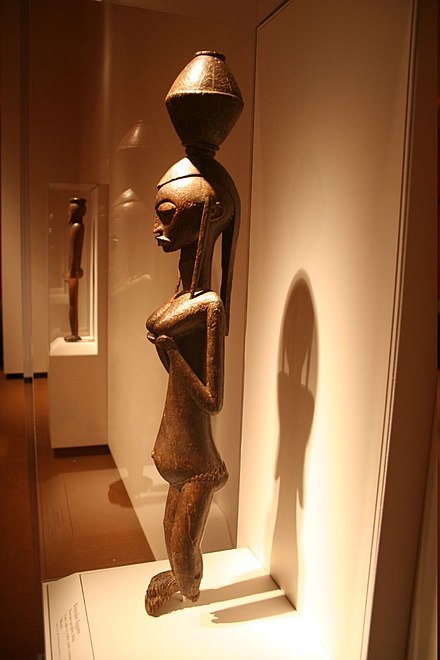
View On WordPress
#African Art#African artifact#African History#Art#Bambara Human Figure#sculpture#West African#west african art
1 note
·
View note
Photo
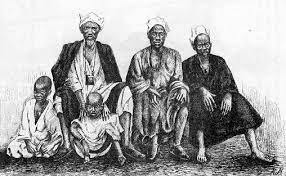
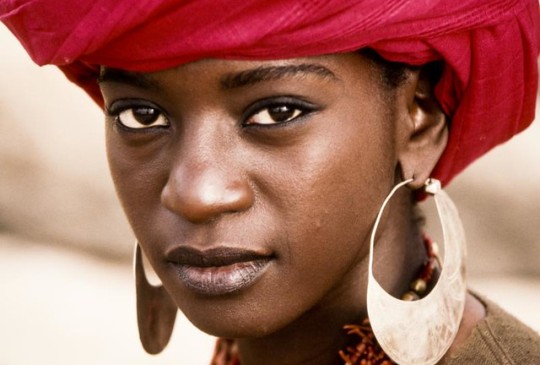
All of the West African groups contributed to the development of Louisiana Voodoo. Their knowledge of herbs, poisons, and the ritual creation of charms and amulets, intended to protect oneself or harm others, became key elements of Louisiana Voodoo.
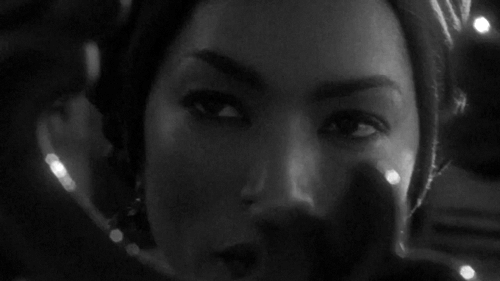
During the French colonial period, around 80 percent of the enslaved Africans brought to Louisiana were from the Bambara people of the Senegal River basin. Most of the other 20 percent were Kongolese, with a few from Dahomey.
After the Spanish took control, increasing numbers of slaves were imported from the Kongo, ensuring a "Kongolization of New Orleans's African American community"
The Bamana originated as a royal section of the Mandinka people. They are founders of the Mali Empire in the 13th Century. Both Manding and Bambara are part of the Mandé ethno-linguistic group, whose divergence is dated to at least about 7,000 years ago, and branches of which are associated with sites near Tichitt (now subsumed by the Sahara in southern Mauritania), where urban centers began to emerge by as early as 2500 BC.

By 250 BC, a Mandé subgroup, the Bozo, founded the city of Djenne. Between 300 AD and 1100 AD, the Soninke Mandé dominated the Western Mali, leading the Ghana Empire. When the Mandé Songhai Empire dissolved after 1600 AD, many Mandé-speaking groups along the upper Niger river basin turned inward. The Bamana appeared again in this milieu with the rise of a Bamana Empire in the 1740s, when the Mali Empire started to crumble around 1559.
According to the Encyclopedia of Africa, "Bambara" means "unbeliever" or "infidel"; the group acquired the name because it resisted Islam after the religion was introduced in 1854 by Tukulor conqueror El Hadj Umar Tall.
#african#brownskin#bambara#new orleans#african american#kongolization#kongolese#louisian voodoo#west african#amulets#mande#niger#bamana#songhai#kemetic dreams
134 notes
·
View notes
Photo
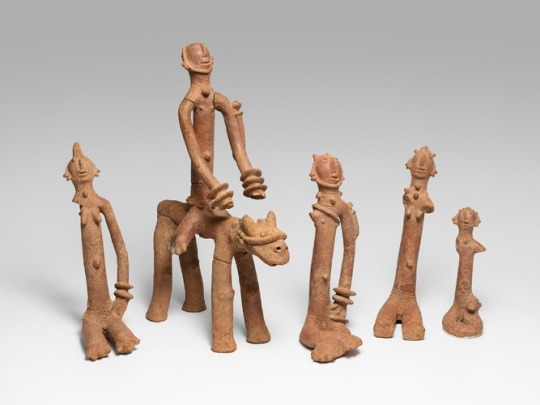
Equestrian and Four Figures, Bankoni, 1175, Art Institute of Chicago: Arts of Africa
Terracotta figures like this set might have served a ritual purpose. The adornment on the figures, including the hairstyles and possible scarification marks, suggest sta- tus and wealth. The horse-and-rider with a knife strapped to his left arm may evoke the significant role that cavalry played in the expansion of empires and control of trade routes in West Africa during past centuries.The descriptive term Bankoni derives from the village where archaeologists unearthed similar objects from the 1950s onward. Located near Bamako, Mali’s capital, this region is today inhabited by the Bamana people, whose ancestors are believed to have made works in a similar style. These five figures were not excavated in a scientific context but recent tests and scans have helped to confirm their age and regional origins. Ada Turnbull Hertle Endowment
Size: Horse and Rider: 70 x 21 x 48.5 cm (27 1/2 x 8 1/4 x 19 in.); Figures: 28.5 x 14.6 x 19.3 cm (17 1/4 x 5 3/4 x 7 5/8 in.); 46 x 14.7 x 19 cm (18 x 5 7/8 x 7 1/2 in.); 44 x 10.2 x 18.5 cm (17 1/4 x 4 x 7 1/4 in.); 28.5 x 12.7 x 18.4 cm (17 3/8 x 5 x 7 1/4 in.)
Medium: Terracotta
https://www.artic.edu/artworks/189597/
19 notes
·
View notes
Photo

The djembe is one of West Africa's best-known instruments. This goblet-shaped drum is traditionally carved from a single piece of African hardwood and topped with an animal skin as a drumhead. In western understanding, the drum belongs to the membranophone class of instruments in the percussion family.
Some say the name of the djembe came from the Bamana in Mali, who said "Anke dje, anke be" to call their people together, as the saying translates as "everyone gathers together." "Dje" means gather and "be" means everyone, which gave the drum used in these calls to order its name.
The djembe drum is most likely about 400-800 years old, and was created during the Malian Empire by the Mandé people. It spanned the modern-day countries of Senegal, southern Mauritania, Mali, northern Burkina Faso, western Niger, the Gambia, Guinea-Bissau, Guinea, the Ivory Coast and northern Ghana.
4 notes
·
View notes
Text
DOWNLOAD @PDF Sahel Art and Empires on the Shores of the Sahara ^DOWNLOAD@PDF#
DOWNLOAD @PDF Sahel: Art and Empires on the Shores of the Sahara ^DOWNLOAD@PDF#
Sahel: Art and Empires on the Shores of the Sahara

[PDF] Download Sahel: Art and Empires on the Shores of the Sahara Ebook | READ ONLINEhttp://read.ebookcollection.space/?book=1588396878
Author : Alisa LaGamma
Publisher :
ISBN : 1588396878
Publication Date : --
Language :
Pages :
To Download or Read this book, click link below:
http://read.ebookcollection.space/?book=1588396878
PDF - KINDLE - EPUB - MOBI
Synopsis : DOWNLOAD @PDF Sahel: Art and Empires on the Shores of the Sahara ^DOWNLOAD@PDF#
A comprehensive exploration, spanning 1,300 years, of the art and culture of the Sahel region of Africa This groundbreaking volume examines the extraordinary artistic and cultural traditions of the African region known as the Sahel (“shore†in Arabic), a vast area on the southern edge of the Sahara Desert that includes present-day Senegal, Mauritania, Mali, Niger, Nigeria, and Chad. This is the first book to present a comprehensive overview of the diverse cultural achievements and traditions of the region, spanning more than 1,300 years from the pre-Islamic period through the 19th century. It features some of the earliest extant art from Africa as well as such iconic works as sculptures by the Dogon and Bamana peoples of Mali. Essays by leading international scholars discuss the art, architecture, archaeology, literature, philosophy, religion, and history of the Sahel, exploring the unique cultural landscape in which these ancient communities flourished. Richly illustrated and brilliantly argued, Sahel brings to life the enduring creativity of the different peoples who lived, traded, and traveled through this crossroads of the world.
0 notes
Note
wait, what? name the african civilisations?? egypt doesn't count, that's more fertile crescent.
Egypt totally counts but whatever List of African kingdoms Non-exhaustive list of known pre-colonial kingdoms and empires with their capital cities on the African continent.North Africa Egyptian Empire (3150–30 BCE)Kingdom of Kerma (2500-1500 BCE)Kingdom of Kush (1070 BCE – 350 CE)Carthaginian Empire (650-146 BCE)Kingdom of Blemmyes (600 BCE-3rd c. CE)Garamantes (500 BCE-700 CE)Ptolemaic Kingdom (306-30 BCE)Kingdom of Mauretania (285 BCE-431 CE and again (533–698 CE)Kingdom of Numidia (202-46 BCE)Kingdom of Makuria (340-1317 CE)Kingdom of Nobatia(350-650 CE)Kingdom of the Vandals and Alans (435 – 534 CE)Post Classical Kingdom of Alodia (7th c.-1504 CE)Kingdom of Nekor (710–1019 CE)Barghawata Confederacy (744–1058 CE)Emirate of Sijilmassa (758–1055 CE)Rustamid imamate (Tahert area, 767–909 CE)Idrisid dynasty (Morocco, 789 - 974 CE)Fatimid Caliphate (910 - 1171)Hammadid dynasty (Western Ifriqiya, 1014–1152 CE)Zirid dynasty (Ifriqiya, 1048–1148 CE)Almoravid dynasty (Morocco, 1040–1147 CE)Khurasanid dynasty (1059–1128 & 1148–1158 CE)Almohad dynasty (Morocco, 1121–1269 CE)Ayyubid dynasty (Egypt, 1171–1254 CE)Hafsid dynasty (Ifriqiya, 1229–1574 CE)Kingdom of Tlemcen (Oranie, 1235–1556 CE)Marinid dynasty (Morocco, 1248–1465 CE)Mamluk Sultanate (Egypt, 1250–1517 CE)Wattasid dynasty (Morocco, 1420–1554 CE)ModernSultanate of Sennar (1504–1821 CE)Saadi principality of Sus and Tagmadert (1509–1554 CE)Saadi dynasty (Morocco, 1554–1659 CE)Naqsid principality of Tetouan (1597–1673 CE)Sultanate of Darfur (1603–1874 & 1898–1916 CE)Republic of Bou Regreg (1627–1668 CE)Alaouite dynasty (Morocco, 1666 - current CE)Muhammad Ali dynasty (Egypt, 1914–1951 CE)Senussi dynasty (Libya, 1951–1969 CE)East Africa Kingdom of Punt - (2400-1069 BCE)Kingdom of Dʿmt (c. 980-400 BCE)Aksumite Empire (50–937 CE)Post Classical Kingdom of Bazin (9th century CE)Kingdom of Belgin (9th century CE)Kingdom of Jarin (9th century CE)Kingdom of Qita'a (9th century CE)Kingdom of Nagash (9th century CE)Kingdom of Tankish (9th century CE)Sultanate of Mogadishu (10th century–16th century CE)Kilwa Sultanate (960-1513 CE)Kingdom of Medri Bahri (1137-1890 CE)Ethiopian Empire (1137–1974 CE)Zagwe dynasty (1137–1270 CE)Solomonic dynasty (1270–1974 CE)Sultanate of Ifat (1285–1415 CE)Warsangali Sultanate (1298–1886 CE)Kingdom of Buganda (1300–present CE)kingdom of Burundi (1500-1966 CE)kingdom of Rwanda (1300-1959 CE)Ajuran Sultanate (14th century–17th century CE)Adal Sultanate (1415–1555 CE)Modern Sennar Sultanate (1502–1821 CE)Empire of Kitara [1]Sultanate of the Geledi (late 17th century–late 19th century CE)Sultanate of Aussa (fl. 1734–present CE)Majeerteen Sultanate (mid-18th century–early 20th century CE)Kingdom of Gomma (early 19th century–1886 CE)Kingdom of Jimma (1830–1932 CE)Kingdom of Gumma (1840–1902 CE)Sultanate of Hobyo (1880s–1920s CE)Dervish State (1896–1920 CE)West AfricaAncient Dhar Tichitt Civilization (1600-300 BCE)Nok Civilization (1000 BCE-300 CE)Djenné-Djenno Civilization (250 BCE-900 CE)Bura Civilization (300-1300 CE)Post Classical EditGhana Empire (700-1240 CE)Kingdom of Nri (948–1911 CE)Bonoman (11th–19th century CE)Mossi Kingdoms (11th century–1896 CE)Takrur (11th - 13th century)Benin Empire (1180-1897 CE)Mali Empire (1235-1600 CE)Jolof Empire (1350-1549 CE)Wolof Empire (1350–1889 CE)Bornu Empire (1380-1893 CE)Oyo Empire (1400–1895 CE)Kingdom of Dagbon (1409- Ce?)Kingdom of Sine (14th-19th century CE)Songhai Empire (1464-1591 CE)Shilluk Kingdom (1490–1865 CE)Empire of Great Fulo (1490-1776 CE)Kingdom of Saloum (1494-1969 CE)ModernMamprussi (16th century CE - ?)Kaabu Empire (1537-1867 CE)Kingdom of Cayor (1549-1879 CE)Kingdom of Baol (1555-1874 CE)Kingdom of Dahomey (1600–1900 CE)Aro Confederacy (1690-1902 CE)Asante Union (1701–1894 CE)Kong Empire (1710–1894 CE)Bamana Empire (1712-1861 CE)Sokoto Caliphate (1804-1904 CE)Wassoulou Empire (1878-1898 CE)Central Africa Ancient Sao Civilisation (6th century BCE-16th century CE)Post ClassicalKanem–Bornu Empire (9th century-1900 CE)Kingdom of Kongo (1400–1888 CE)ModernSultanate of Bagirmi (1522-1897 CE)Luba Empire (1585–1885 CE)Kingdom of Ndongo (16th century-? CE)Kingdom of Matamba (1631-1744 CE)Wadai Empire (1635-1912 CE)Lunda Empire (1660–1887 CE)Kingdom of Lunda (1665-1887 CE)Kuba Kingdom (1600–present CE)Southern Africa Post ClassicalKingdom of Mapungubwe (9th century–14th century CE)Kingdom of Zimbabwe (1220–1450 CE)Kingdom of Mutapa (1430-1760 CE)Kingdom of Butua (1450-1683 CE)Torwa dynasty (1450-1683 CE)Modern Rozwi Empire (1660-1866 CE)Ndwandwe Kingdom (1780-1819 CE)Zulu Kingdom (1816–1897 CE)Merina Kingdom (18th century- 1896 CE)Mthethwa Paramountcy (18th Century - 1820 CE)
23 notes
·
View notes
Text
The Aro Confederacy and Bamana Empire share aspects of their history:
The Aro Confederacy and Bamana Empire are two products of the history of the slave trade and the rise of states that sought to exploit it. In doing so they yoked their economy to the long chain of misery and raids that it brought, and in doing so they left themselves exposed to when industrialism meant the trade was meaningless to both conquest and the dismantling of the Faustian concept that underpinned the states.
With the Aro, in particular, there arose a narrative of cannibalism pushed by largely indirect reports, as with many Caribbean Indigenous American peoples. Cannibalism was and is a popular allegation in old-model societies to put one's neighbors beyond the pale. It does not have any basis from the self-perception of the Aro, but worked neatly to justify the expansion of what became the Nigerian colony and to present the conquest as anything but a selfish absorption of an old trading partner where the trade in question was now subject to that Victorian conceit that the Empire had profited from slavery merely to abolish it.
#lightdancer comments on history#black history month#aro confederacy#african history#nigerian history#british empire
4 notes
·
View notes
Text
Events 3.10
241 BC – First Punic War: Battle of the Aegates: The Romans sink the Carthaginian fleet bringing the First Punic War to an end.
298 – Roman Emperor Maximian concludes his campaign in North Africa and makes a triumphal entry into Carthage.
947 – The Later Han is founded by Liu Zhiyuan. He declares himself emperor.
1496 – After establishing the city of Santo Domingo, Christopher Columbus departs for Spain, leaving his brother in command.
1535 – Spaniard Fray Tomás de Berlanga, the fourth Bishop of Panama, discovers the Galápagos Islands by chance on his way to Peru.
1607 – Susenyos I defeats the combined armies of Yaqob and Abuna Petros II at the Battle of Gol in Gojjam, making him Emperor of Ethiopia.
1629 – Charles I dissolves the Parliament of England, beginning the eleven-year period known as the Personal Rule.
1661 – French "Sun King" Louis XIV begins his personal rule of France after the death of his premier, the Cardinal Mazarin.
1735 – An agreement between Nader Shah and Russia is signed near Ganja, Azerbaijan and Russian troops are withdrawn from occupied territories.
1762 – French Huguenot Jean Calas, who had been wrongly convicted of killing his son, dies after being tortured by authorities; the event inspired Voltaire to begin a campaign for religious tolerance and legal reform.
1814 – Emperor Napoleon I is defeated at the Battle of Laon in France.
1830 – The Royal Netherlands East Indies Army is created.
1831 – The French Foreign Legion is created by Louis Philippe, the King of France, from the foreign regiments of the Kingdom of France.
1848 – The Treaty of Guadalupe Hidalgo is ratified by the United States Senate, ending the Mexican–American War.
1861 – El Hadj Umar Tall seizes the city of Ségou, destroying the Bamana Empire of Mali.
1873 – The first Azerbaijani play, The Adventures of the Vizier of the Khan of Lenkaran, prepared by Akhundov, is performed by Hassan-bey Zardabi and dramatist and Najaf-bey Vezirov.
1876 – The first successful test of a telephone is made by Alexander Graham Bell.
1891 – Almon Strowger patents the Strowger switch, a device which led to the automation of telephone circuit switching.
1906 – The Courrières mine disaster, Europe's worst ever, kills 1099 miners in northern France.
1909 – By signing the Anglo-Siamese Treaty of 1909, Thailand relinquishes its sovereignty over the Malay states of Kedah, Kelantan, Perlis and Terengganu, which become British protectorates.
1922 – Mahatma Gandhi is arrested in India, tried for sedition, and sentenced to six years in prison, only to be released after nearly two years for an appendicitis operation.
0 notes
Photo
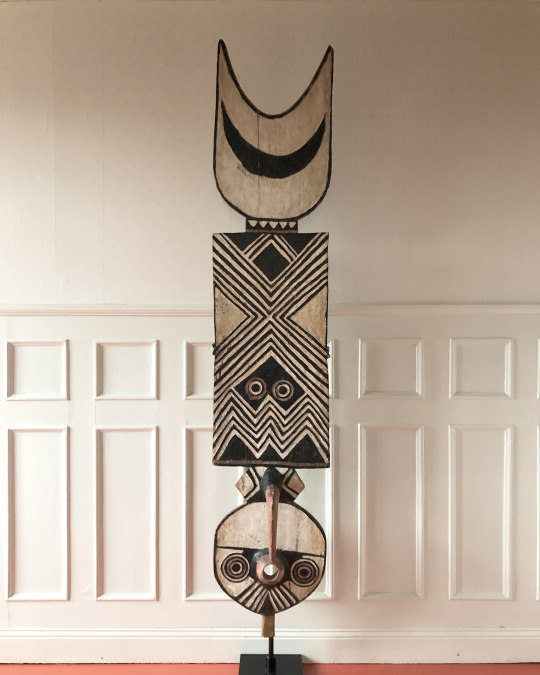
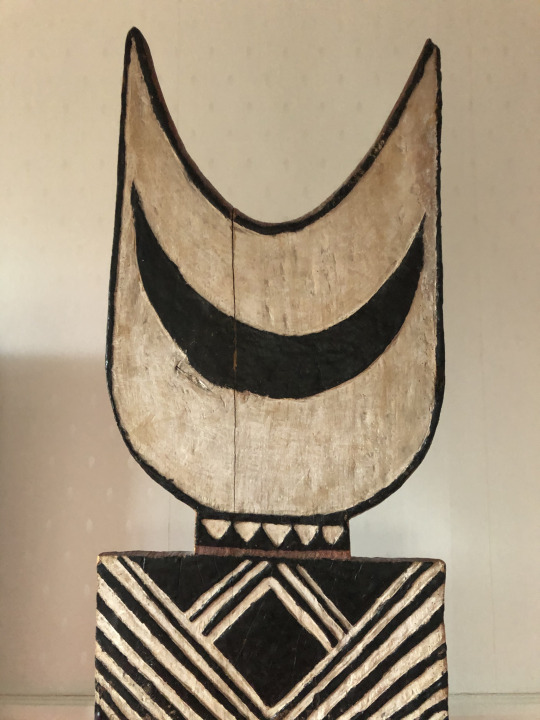
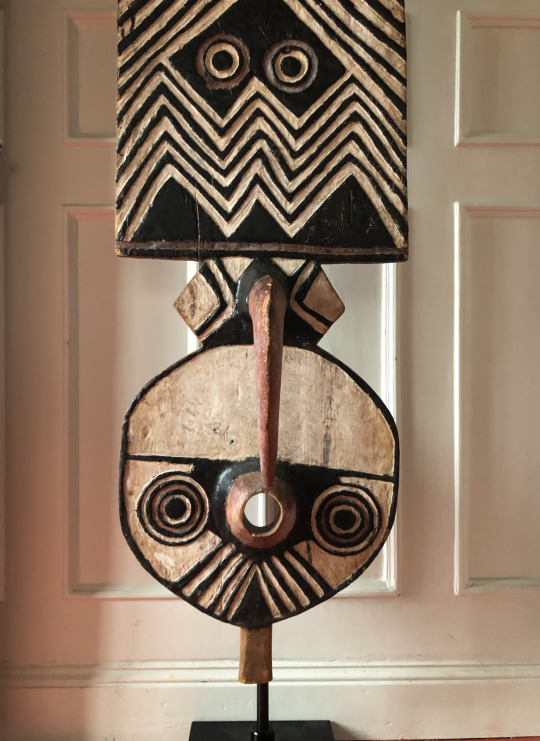
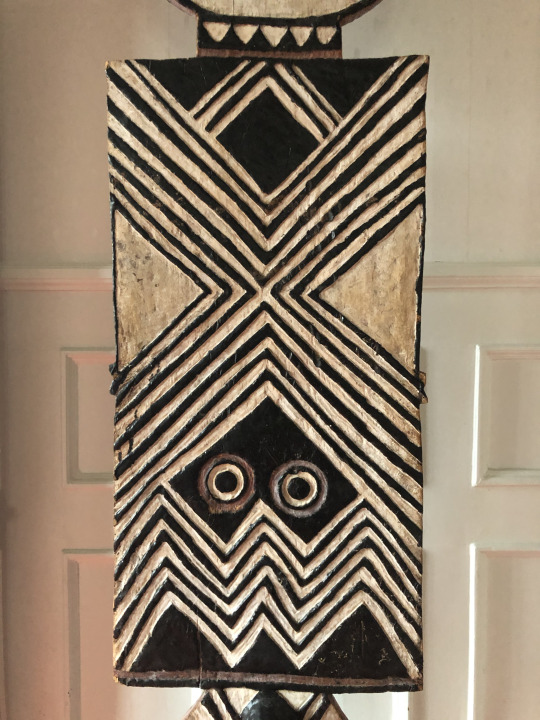
Bwa Nwantantay mask, Bondé-klanen,Boni, Burkina Faso
Ex Richard Wahlgren. Ex Jan Lundberg (1993)
Some of the largest and most impressive masks – over two meters high – used and still in use in Africa are the plank masks of the southern Bwa. The Bwa people live in western Burkina Faso and subsist on agriculture – since the French invasion at the end of the 1800s, almost exclusively cotton. They live in autonomous societies where the elders of the various clans rule. It is also the respective clan that is responsible for the different masks and their dances
. The Nwantanay mask has a circular face with a round mouth opening that the dancer can see through and two circular eyes depicted as targets. Above the face sits a rhombus with a long reddish-brown beak shape. The central part of the mask is a vertical rectangle with a horizontal zigzag pattern that represents the path chosen by the ancestors and the challenge of following in their footsteps. Above the pattern are two more target-shaped eyes which, together with the round mouth, symbolize the sacred springs in Boni. A cross consisting of several thin black lines is placed in the middle of the rectangle and depicts the traditional scar tattoo of the Bwa people that used to be done on the forehead of the initiates. Above the rectangle, a narrow section with small white triangles representing bull roarers connects the rectangle with the crescent moon that crowns the mask. The new moon represents the timing of initiation rites in Bwa society.
The meaning of the symbols varies between different clans and they often have diverse connotations depending on how initiated one is. A symbol may mean one thing to a young initiate, another to an adult family man, and yet another to one who belongs to the village elders.
Bwa masks are based on family or clan myths and often symbolize animal spirits such as antelopes, snakes or butterflies, or spirits in human form, which interacted in various ways with the ancestors. Nwantanay, on the other hand, is an abstract mask that symbolizes a flying spirit that may be connected to water. The spirit can, for example, take the form of insects in a marsh or one like an owl or Ibis bird. The mask's form is not representative and its inherent supernatural powers serve the clan to which the mask belongs.
Most Bwa used to apply leaf masks (bieni) representing Do, the spirit that acts as mediator between god (Difini or Dobweni) and people. Do is also the plant power that produces fruit and game, and that makes the ground fertile.
During the 19th century, the Bwa communities were heavily affected by slave hunters from the Bamana Empire in Segu and from muslim Fulani in eastern Burkina Faso. To change their fate, they borrowed the mask cult from the neighboring Winiana and Nuna peoples. In this way, they gained spiritual strength to cope with adversity. The fact is that several ethnic groups in Burkina Faso have the same or similar masks and above all the graphic coloring in black white and red, and the round target-board eyes are found in many different cultures such as the Mossi.
The masks are made from Kapok, also called cottonwood, which is a light type of wood but with dense annual rings. The masks are made by blacksmiths and colored with a white pigment that traditionally consists of snake feces but is often replaced by ground school chalk. The red pigment is created from iron-containing hematite rock that is ground into a powder. Gum arabic and eggs are used as binders. The black tarry pigment known as gbonkahû is made by boiling the seed pods of the Acacia tree.
To protect the fragile wood of the masks from pests, they are submerged in a swamp or river between dance seasons. They are weighed down with stones for several weeks and when they are picked up the water-soluble white and red pigments have disappeared while the black tarry pigment is intact. Hence, the masks are re-dyed before each season and the black parts get higher and higher relief with the age of the mask.
Initiation rites are an important part of Bwa societies. Boys and girls are "kidnapped" by older relatives and taken to a secret place where they are stripped naked and forced to sleep in the open air without blankets. They then learn the stories of how spirits and the various masks they embody have contacted their ancestors and the meaning of the symbols found on the masks. The costumes that go with the masks are manufactured from hibiscus fiber, the boys learn the mask dances and the girls learn the songs that go with the different dances. Both boys and girls are circumcised during the initiation rite, something that is unfortunately still common in West Africa.
When the training and rituals are completed, the children return to the village where they get to show off their skills in dance and song and if they are approved, they get to see their families again, but are then seen as adults, ready to start a family of their own.
Even at funerals, the masks belonging to the deceased's clan or family dance. And another important occasion when the masks dance is when the harvest is done in November or December. Nowadays, the masks sometimes even dance in early spring when the payment for the cotton harvest comes.
When the Nwantanay mask is danced, the dancer turns the head and upper body to the maximum to the right, jumps up and rotates 360 degrees to quickly rotate back. The movement is repeated several times, creating a visually impressive spectacle.
Not all dancing have ritual meaning. When there is a market, the masks dance partly to entertain and compete with each other, partly as a way for the young dancers to impress the opposite sex, and young women leave gifts for the most impressive mask dancers. In this way, the Bwa masks also have a function in the future of society.
Tommy Carlsson 2022
(Stokstad, Art, a Brief History pp. 437-438, Roy, The Art of Burkina Faso, University of Iowa pp. 4, 45-59)
0 notes
Photo
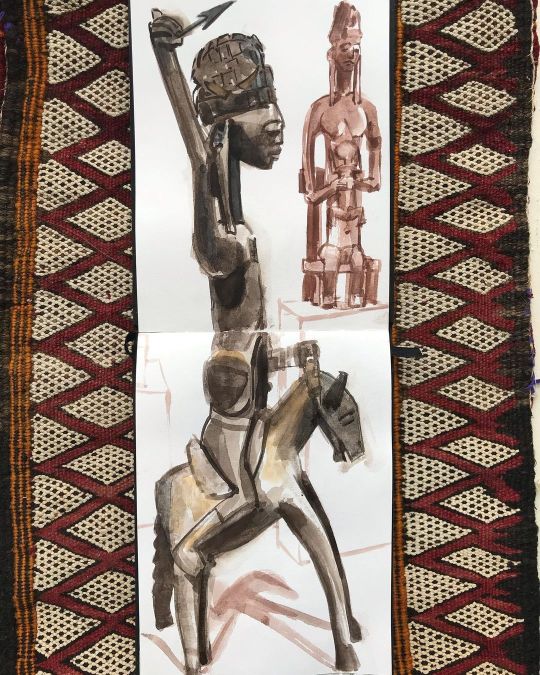
So glad I was able to catch the exhibition “Sahel: Art and Empires on the Shores of the Sahara” on its last day at the Met. Bamana equestrian warrior from the Segu elite corps, Mali. Watercolor, October 2020 #sahel #metsahel #alisalagamma #africanart #mali #bamana #sculpture #equestrianart #equestriansculpture #metropolitanmuseum #metmuseum #themet #aquarelle #watercolor #fredericlere (at The Metropolitan Museum of Art, New York) https://www.instagram.com/p/CG3EwwKHB2E/?igshid=14f1cb6z4bv2x
#sahel#metsahel#alisalagamma#africanart#mali#bamana#sculpture#equestrianart#equestriansculpture#metropolitanmuseum#metmuseum#themet#aquarelle#watercolor#fredericlere
0 notes
Text
Desert Empires: Wonders to Behold
Bucket lists form early. When I was, maybe, 10, flipping through books in my grandfather’s house I came across a photograph of the Great Mosque at Djenné in Mali, West Africa, and thought, this is the strangest, most wonderful, most outer-space building I’ve ever seen. Beige-color and turreted, it was as soft-edged as a sand castle, but huge, dwarfing people in street. I wanted to go there.
I eventually did — stood, rapt, gazing at the Great Mosque’s walls in sunlight and moonlight. And on a visit last week to the exhibition “Sahel: Art and Empires on the Shores of the Sahara” at the Metropolitan Museum of Art, I felt a little like I was there again, but now with other extraterrestrial sights to take in, including sculptures as sublime as the mosque itself.
Sahel derives from the Arabic word for shore or coast. It was the name given by traders crossing the oceanic Sahara centuries ago to the welcoming grasslands that marked the desert’s southern rim, terrain that now includes modern Mali, Mauritania, Niger and Senegal. On the evidence of art from the Sahel, the culture that travelers encountered must have looked like a rich but bewildering hybrid. The art still does, which may be one reason it stands, in the West, somewhat outside an accepted “African” canon.
The West has always viewed Africa narrowly, categorically, as a way of exerting control. So African art means carved-wood or metal sculpture in stand-alone “tribal” styles that never change. Or it means riffs on forms borrowed from somewhere else — Renaissance Europe, say, or the greater Islamic world. One way or the other, African art is a thing. You can recognize it instantly, and put it by itself in a case with a label.
The Met show demonstrates otherwise. One look around tells you that the story here is variety within variety, difference talking to difference. New ideas spring from local soil and arrive from afar. Ethnicities and ideologies both collide and embrace. Cultural influences get swapped, dropped, and recouped in a multitrack sequencing that is the very definition of history.
To assert that the art of Africa has a history, or histories, is very much the show’s goal. And if the history of art from the Sahel is difficult to map that’s because so much has disappeared. Nature and ideologically driven destruction have seen to that. Much has been displaced by amateur digging and looting. Untold amounts of material still lie hidden in the ground.
Given all that, the 200 hundred objects gathered at the Met are, simply by being here, a wonder to behold. And the show’s organizers — Alisa LaGamma, curator in charge of the department of arts of Africa, Oceania and the Americas; associate curator Yaëlle Biro; and research associate Hakimah Abdul-Fattah — have skillfully shaped that wonder into a linear narrative.
It’s introduced by two sculptures that are among the oldest on view and feel monumental in very different ways. A seven-foot-tall megalith, dating from the 8th- 9th century A.D. is by far the show’s largest work. But with its russet surface and plump V shape it has a hunkering delicacy. The second sculpture is much older — pre-2000 B.C. — small: pebble-size. But with a few lightly incised tweaks a resourceful artist has conjured an icon of procreative female power.
What the intended meaning or ritual use of these objects actually was, we don’t know. But they provide a baseline of antiquity for the curators to build a history on. And so they do, plotting it almost diagrammatically, by dates and themes, in two rows of mini-galleries with a wide path between. And they line the path with a kind of honor guard of a dozen equestrian sculptures in terra-cotta, metal and wood.
The cavalcade is a beautiful idea. The images, produced over a wide time span, from the 3rd and 19th centuries, by cultures in present-day Mali and Niger, are widely varied in media, style and probably function, but lined up together they suggest a kind of symbolic solidarity, an affirmation of the integrity and complexity, past and present, of something called the Sahel.
A major invasive event during that time span was the coming of Islam, which hit the Sahel shores in the 7th century, and stayed, and spread. Because Islam introduced literacy, it had pervasive and subversive impact. But, maybe in an effort to correct an old view that Islam was responsible for Sahel culture’s vitality, neither it nor any other outside trans-Saharan force is given a center stage in the show.
(A traveling exhibition called “Caravans of Gold, Fragments in Time: Art, Culture, and Exchange Across Medieval Saharan Africa,” organized by the Block Museum of Art, Northwestern University, addresses these interactions. The show is at the Aga Khan Museum in Toronto through Feb. 23, and moves on to the National Museum of African Art, Smithsonian Institution in Washington D.C.)
The focus instead is on indigenous art that either predated the widespread adoption of Islam in the Sahel, or remained relatively untouched by it.
Textile fragments from the Bandiagara region of central Mali, which are some of the oldest to survive in Africa, fit into this description. So does the extravagantly filigreed disk known as the “Rao Pectoral,” a Senegalese national treasure that is also a glowing advertisement for the genius of African goldsmithing.
But it is sculpture, and specifically some 20 terra-cotta and wood Middle Niger figures, that forms the visual and emotional heart of the show. At least one of these pieces is world-famous: a half-reclining terra-cotta figure, androgynous, headless, superbly detailed, and found by the archaeologists at the site of Djenné-Djeno, an ancient city in what is now Mali that was mysteriously abandoned around 1400 A.D.
Whatever the crisis — political? or economic? environmental? — that led to the city’s demise seems to have affected that entire region. And it was preceded by an almost convulsive surge of artistic creativity that generated some of the moving sculptures ever made, including those seen here.
In one, a figure of ambiguous gender presses its head to the earth as if in grief or prayer. In another, a woman folds her arms across her bare chest in a gesture of devotion or self-protection. In a third, a tall, curving wood-carved figure with hermaphroditic features has the en pointe grace of a Chartres saint. Some forms are nearly abstract; worshipers with tuning-fork bodies reach up beseechingly toward the sky. And some exhibit a kind of pathological realism, as in the case of a terra-cotta figure whose body sprouts tumor-like knobs. (Like most ritual clay figures of the time, this one was probably made by a woman.)
The exhibition concludes with still more Sahel sculpture, a magnificent ensemble of large-scale figures carved from wood by the Bamana people of Mali in the 18th through 20th centuries. Together they represent a type of “African art” we’ve been accustomed thinking of as typical, or “classical.” Yet by the time you’ve arrived at this end point in the show you’ve learned that, in the culture of the Sahel, there is no “typical,” no one style, no one “Africa,” and that’s an invaluable lesson.
And, these days, the Met’s gorgeous show is the place to learn it. Vast areas of the Sahel, specifically Mali, are politically turbulent, and difficult, if not impossible, to access. (Recent United States government travel advisories have declared northern and central part of the country, which includes Djenné, a no-go zone for tourists. “Do not travel to Mali due to crime, terrorism, and kidnapping,” is how they put it.) It won’t be that way forever. I can’t wait to go back. It’s still on my must-see list. I’ll never take it off.
Sahel: Art and Empires on the Shores of the Sahara
Through May 10 at the Metropolitan Museum of Art, Manhattan; 212-535-7710, metmuseum.org.
from WordPress https://mastcomm.com/desert-empires-wonders-to-behold/
0 notes
Photo

Equestrian and Four Figures, Bankoni, 1175, Art Institute of Chicago: Arts of Africa
Terracotta figures like this set might have served a ritual purpose. The adornment on the figures, including the hairstyles and possible scarification marks, suggest sta- tus and wealth. The horse-and-rider with a knife strapped to his left arm may evoke the significant role that cavalry played in the expansion of empires and control of trade routes in West Africa during past centuries.The descriptive term Bankoni derives from the village where archaeologists unearthed similar objects from the 1950s onward. Located near Bamako, Mali’s capital, this region is today inhabited by the Bamana people, whose ancestors are believed to have made works in a similar style. These five figures were not excavated in a scientific context but recent tests and scans have helped to confirm their age and regional origins. Ada Turnbull Hertle Endowment
Size: Horse and Rider: 70 x 21 x 48.5 cm (27 1/2 x 8 1/4 x 19 in.); Figures: 28.5 x 14.6 x 19.3 cm (17 1/4 x 5 3/4 x 7 5/8 in.); 46 x 14.7 x 19 cm (18 x 5 7/8 x 7 1/2 in.); 44 x 10.2 x 18.5 cm (17 1/4 x 4 x 7 1/4 in.); 28.5 x 12.7 x 18.4 cm (17 3/8 x 5 x 7 1/4 in.)
Medium: Terracotta
https://www.artic.edu/artworks/189597/
2 notes
·
View notes
Text
The Asante Empire has left its own global impacts:
The Asante Kingdom has left its own marks in two notable fashions. One is very literally fashion in the form of Kente cloth, which has become a pan-African symbol and originated as the sartorial choice of Asante and Dagbon nobility and royalty. The other is that it represented one of the first African states to grapple with Europeans, outside the various Sultanates in Morocco. It also experienced a great deal of success in this, if at a high price.
To preserve its independence it developed a strong centralized ethos of absolutism under its founding ruler Osei Kofei Tutu. It, like the Kingdoms of Dahomey and Benin and the Aro Confederacy and the Bamana Empire was also a direct beneficiary of the slave trade in the short term and undermined by it in the medium and long terms. Asante and Dahomey and Benin were the first to appreciate the power of firearms and the revolutions they portended, and among the cultures with the most deep integrations of this new technology into their own cultures.
0 notes
